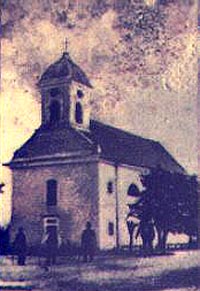|
A
Visit to Nitzkydorf
- 1989
In
October of 1989, Duncan Gardiner, a
professional researcher, visited Nitzkidorf to seek information on
the Dassinger, Seffernick, and
Augustine families for Dorothy
Acton. At the time of this
visit, Roman was under the
Ceausescu regime. Two months
later, the dictator fell.
Report of Duncan
B. Gardiner
on Nitschkidorf, Rumania 1989
© Nitschkidorf Report
and Photos 1989
Duncan B. Gardiner,
Ph.D., C.G. © 1989
Duncan B. Gardiner,
Ph.D., C.G.;
Permission granted to
DVHH.org to republish
his report on Nitschkidorf,
Rumania.
[Published at
DVHH.org 05 Mar
2010
by Jody McKim
Pharr]
|
 |
|
1.
On Friday, 13 October
1989 I visited the
Bishopric; Str. Matei
Corvin Nr.2) in
Timisoara, Rumania and
spoke with Dr. Ferdinand
Cziza. He told me that
the Nitschkidorf parish
records are held in the
Timisoara Archives (Bodnaras
Str 8, Timisoara). I had
previously heard in
Vrsac, Yugoslavia, that
the Roman Catholic
bishop's duplicate
parish records for the
entire Banat may also be
there. While at the
Bishopric, I also spoke
with Sebantian Krauter
who appears to be the
appointed bishop of the
region. It appears he
could not use the title
officially in Rumania
because of government
policy. Sebastian
Krauter was born and
raised in Nitschkidorf
and gave me the name of
a contact in the town.
I
travelled to
Nitschkidorf later that
day. It is only some 20
miles from Timisoara,
but the road is not
paved. The last five
miles is so rutted and
uneven that maximum
speed was ten miles an
hour. Mr. Graszl turned
out to be a retired
tailor who was
choirmaster of the Roman
Catholic Church. He
speaks excellent German,
his native language. Up
until five years ago,
the congregation was
large enough to have a
choir, but Nitschkidorf
is now mostly Rumanian
non-Catholic. Mr. Graszl
was nice enough to open
the church for me and
allow me to take the
photographs which are
enclosed with this
report. He also played
the organ for me.
In
the cemetery I noted no
grave markers older than
the 1890's. There were
quite a few graves;
enough to make a
thorough search
impossible before the
end of the day. All the
markers are dazzling
white stone; there was
half a dozen ladies
scrubbing headstones
with soap and brush.
Most of the graves were
tended immaculately. I
asked about Dassinger
family graves and was
directed to Wendel
Dassinger's, photo
enclosed. It reads: Here
rests Wendel Dassinger,
died 8 April 1916 in his
52nd year. Rest in
peace." So he was born
in 1864 or 1863. I noted
no other Dassinger
graves. There appeared
to be several Augustin
head markers, but none I
could connect with data
you gave me and none
from before 1900.
We
returned to his house
where he showed me a
kind of register of all
the German families
living in the village.
He had two Dassinger
family addresses, for
Franz Dassinger and
Georg Dassinger. I asked
him about Sefernick and
Augustin families, but
there do not appear to
be any living in
Nitschkidorf now.
| | | |